In this article, I share my research about the pagan origins of the Santa Claus character, his chariot and reindeer, Christmas traditions, and the holiday itself.
Bishop Nicholas
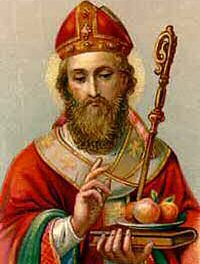
Bishop Nicholas of Myra
Santa Claus is closely associated with bishop Nicholas, who was the bishop of Myra (modern Turkey), a city in the Roman Empire.
Unfortunately, the Byzantine church was built on the ruins of the temple of Poseidon, which should have never been done since God told us to have nothing to do with the heathen.
The bishop of that church got possessed with the spirit of Poseidon, and therefore acquired powers of this sea-god.
He was able to manipulate nature and do all sorts of miracles. He would also go out secretly at night on his white horse and leave gifts in people’s homes.
When the Catholic church heard about this miracle man, they canonized him as a saint. And thus, Saint Nicholas was born. He wore as bishops did, a traditional red bishop’s outfit trimmed in white ermine, and the pointed bishop’s hat.
The Dutch still have festivals associated with this saint, mainly St. Nicholas’ Eve which is celebrated on the 5th of December, and the following day which they call Saint Nicholas Day.
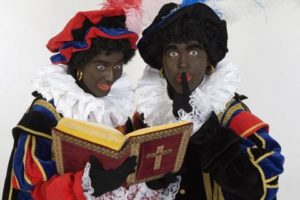
Zwarte Piet
He’s accompanied by two black-faced companions often wearing feathered caps called Zwarte Piet.
Their faces are told to be black due to the soot of the chimneys.
Some researchers, like Helene Adeline Guerber, assert that the origin of Sinterklaas and his helpers is linked with the Wild Hunt (I write about it further down) of the Germanic god Woden.
Woden had two black helper ravens who would listen and observe what’s happening in the world and report to their master what they’ve heard of seen. Likewise, the black-faced helpers of Sinterklaas report what they’ve heard children say.
Odin and His Eight-Legged Horse
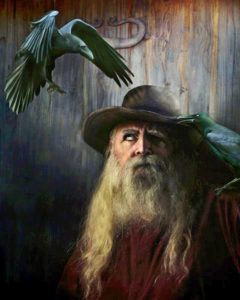
Nordic god Odin
Odin (Oden, Oddin) was a widely revered god in pagan Nordic countries, especially among the Germanic peoples.
It’s believed that this figure was derived from the ancient Germanic god of the wind and the dead, Wodan (Woden).
This one-eyed long-bearded god who is sometimes revered as an ancestral spirit was associated with healing, death, royalty, knowledge, war, sorcery, poetry and frenzy.
He was also known in Old English as Woden who had a female counterpart Freya.
Odin traveled on his eight-legged horse across the sky as well as to the underworld called Hel, which is the same as English hell, derived from the same proto-Germanic noun meaning “the underworld”.
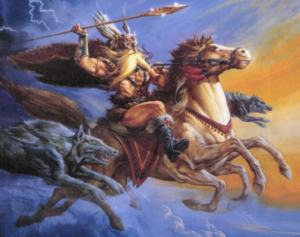
Oden’s eight-legged horse Sleipnir
The name of his eight-legged flying horse was Sleipnir in Old Norse mythology, which meant “slippy, or “the slipper”.
The horse was a child of Loki and Svadilfari, a god of the race of giants of Norse mythology, who turned into a mare and mated with a stallion by the name of Svadilfari meaning “unlucky traveler”.
That wasn’t the only animal companion of Odin; he also sometimes was accompanied by two wolves or two ravens who seemed to be familiar spirits as they brought him information from other places.
The wolves named Geri and Freki translated “the greedy one” and “the hungry one” would roam the field greedy for the corpses of those who have fallen in battle.
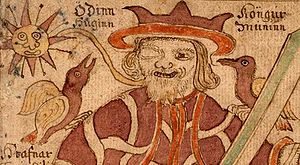
Woden’s ravens
The two ravens Huginn and Muninn whose names mean “thought” and “mind” or “memory” flew all over the world to report everything they saw and heard to their master Odin.
He was afraid to lose these two precious companions because they caused him to appear very wise and all-knowing.
Because of these messengers, he was sometimes called the god of ravens. Ravens are also associated with Apollo, the Greek god of music. Some believe that Lucifer was a chief musician in heaven.
Upon more research I came to the conclusion that the Norse god Odin was nothing less than Satan himself since he was always in search of information (probably of how to usurp the throne of God), he also boasted of creating the world by slaying the original Creator which well ties in with Hindu and Greek myths.
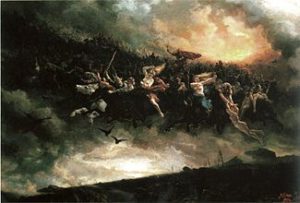
Wild Hunt
Oden also appears as a leader of the wild hunt, a ghostly procession of the dead through the winter sky.
Wild hunt involved a ghostly or supernatural group of huntsmen passing in wild pursuit.
They were believed to be either be elves, or fairies, or the dead. Their leader was usually Oden.
Seeing wild hunt often thought to presage some catastrophe such as war or plague, or at best the death of the one who witnessed it. It was believed that people encountering the hunt might be abducted to the underworld or the fairy kingdom.
So in ancient days seeing ghost-like beings in chariots with horses in the sky were a sight of dread; these days children desire to see Santa Claus in the sky!
It was also believed that people’s spirits could be pulled away during their sleep to join the wild hunt. This ghostly procession was also called wild army, ghost riders, or furious army.
Could that be the relic of a true story of how disobedient angels of God descended to copulate with human women, and therefore for this transgression were not allowed to ascend back into the heavens and thus for the time being roamed the earth, until being sent to the underworld? Or this could be the evil spirits of giants, the offspring of human women and fallen angels, who were told to do only evil in the world.
Whatever it is, it’s definitely associated with evil beings that were mistakenly called “gods” by pagans and in many countries’ myths we find their descriptions of battles between each other, riding chariots in skies, and causing grief to humans.
Some tales associate the hunter Oden with a dragon or the devil himself, whilst some associate him with giants. Sometimes this hunter is depicted not as riding the horse but as a horse-drawn carriage.
Usually the prey of the wild hunt were young women, which, in this case, would make the members of the furious army most likely to be fallen angels. Sometimes they would slay humans or animals.
People would try to avoid these supernatural huntsmen by lying at the ground level as it was believed that Odin would not descend so low. This seems to have given birth to the belief that lighting is less likely to strike people who lie at the ground level, which also might point to the fact that the wild hunt was associated with lightning. Lightning is associated with Lucifer in the Bible, and demons themselves have electrical nature as I’ve already explained in one of my videos.
Odin was also associated with charms and other forms of magic, as well as disguise, and for this reason one of his symbols was a mask.
Further evidence that Odin and Satan are one and the same being could be found in Jacob Grimm’s interpretation of the Wild Hunt. He argued that the male figure who appeared in it was a survival of folk beliefs about the god Wodan who had…
(…) lost his sociable character, his known features, and assumed the aspect of a dark and dreadful power… a ghost and a devil.
Isn’t that similar to the Biblical account of how Lucifer was once the most beautiful being in Heaven and because of his pride he wanted to lift himself above God and was struck down to the ground and is now a fallen creature?
Since Satan loves being worshiped and is worshiped in many forms, why would it be surprising that he managed to get worship even under the disguise of a Christian holiday?
Sometimes people would bring gifts when encountering wild hunts, probably to appease the furious army so that they wouldn’t kill them. Children to this day offer milk and cookies for Santa Claus, and this might also be related to the pagan custom of leaving food offerings for the dead.
Nordic Yule Celebration
In Nordic countries, the celebration connected with the wild hunt is called Yule or Yuletide. It was later christianized and became known as Christmastide. Some pagan traditions have been adopted from Yule and brought into the celebration of Christmas, such as Christmas log which was called Yule log and is very likely to be the relic of ancient Celtic human sacrifices.
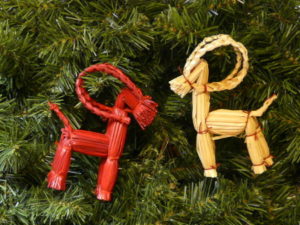
Straw Yule goats
Yule goat is another Christmas symbol that’s pagan.
It’s likely connected with the Nordic god Thor, which was the hammer-wielding God associated with lightning, thunder, storms, oaks, and fertility, so this seems to be yet another manifestation of Satan.
God Thor rode in the sky in a chariot drawn by two goats.
The tradition with the Yule Goat shifted through time. It’s sometimes associated with small straw goats hung on Christmas trees. In the past, people would dress up in a rowdy way to look like a scary creature who would demand gifts.
Only during the nineteenth century, the role of the Yule goat shifted to a benevolent gift-giving role. In Scandinavia, the Yule Goat is best known as a Christmas ornament and a giant Yule goat made of straw is erected in towns and cities around Christmas time.
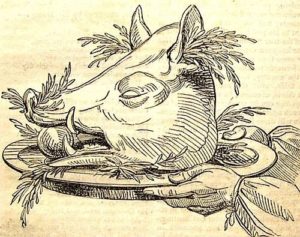
Yule boar
Yule boar is yet another pagan element incorporated into the celebration of Christmas known as Christmas ham.
Among the Germanic peoples, the wild pig was a tribute to their god Freyr which was pictured as a phallic fertility god.
The wild pig was sacrificed for this god in the hope that he would show them favor in the coming year.
The boar’s head with an apple in its mouth was carried on a gold or silver platter to the sounds of trumpets and songs to be offered to this pagan deity.
Yule singing also got incorporated into Christmas as caroling. Originally it was the tradition of visiting cider-producing orchards reciting incantations and singing to the trees to promote a good harvest for the coming year.
Yule was the time of feasting, drinking alcohol, and animal sacrifice. Ancestor spirits were likely to have been venerated at that time too. Children would leave their boots by the chimney filled with carrots and hay to feed Odin’s eight-legged horse Sleipnir.
Furious Host
The furious host mentioned in connection with Odin is also encountered in the myths of other countries.
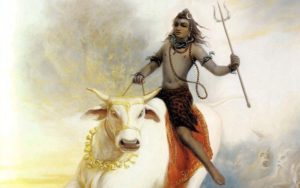
Shiva on Nandi bull
Bhagavata Purana (India) mentions a similar furious army led by the demon Shiva who was accompanied through the skies with horrible-looking ghosts called bhutaganas.
They were also known as ghostly hosts.
He sat on his Nandi bull. When he was seen in the sky with the ghostly procession, it was considered the most inauspicious time. (This is mentioned in Bhagavata Purana, Canto 3, Chapter 14, verses 23-24.)
We encounter the accounts of the wild hunt in Ireland and Scotland also.
In Irish and Scottish folklore such wild hunt is associated with evil spirits that neither the earth, nor heaven, nor hell welcomes which might be the evil spirits mentioned in the Book of Enoch begotten of the fallen angels and human women.
They are always depicted as troublesome and destructive and fly in groups. They attempt to snatch away the souls of dying people. They are seen as fighting battles between each other.
They are called Sluagh. They can shape-shift and thus appear as human beings. They like to walk in the air above the areas where mortals dwell. They carry sharp weapons and sometimes ride skeletal horses.
Sluagh becomes strongest at around the time of Halloween when the veils between the realms of humans and spirits are the thinnest.
Saturnalia – a Roman Celebration of Drunken Frenzy
Saturnalia is another celebration that’s blended with Christmas. The poet Lucian of Samosata (AD 120-180) has the god Cronus (in Ancient Rome known as Saturn) say in his poem Saturnalia:
During my week the serious is barred: no business allowed. Drinking and being drunk, noise and games of dice, appointing of kings and feasting of slaves, singing naked, clapping of tremulous hands, and occasional ducking of corked faces in icy water – such are the functions over which I preside.
Publius Papinius Statius, a 1st century AD Roman poet, recounts in his work Silvae:
December tipsy with much wine, and laughing Mirth and wanton Wit,” remembering “the glad festival of our merry Caesar and the banquet’s drunken revel.
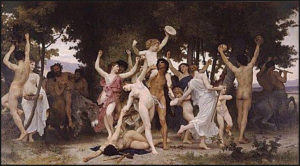
Drunken Saturnalia frenzy
It was lawful to be drunken, slaves could hate their masters, loot their friends’ tables, elect the kings, and acknowledge them for royalty.
Lawlessness, cruelty, and drunken frenzy were compared to how things were in the Golden age when Cronus was told to be the ruler of humanity.
All public and private business dealings were prohibited unless they were connected with the celebration, like cooking and baking.
Lucian writes:
No discourse shall be either composed or delivered, except it be witty and lusty, conducing to mirth and jollity.
Zeus, Hermes, and Apollo were worshiped on the eve of the feast. People were giving gifts to each other. If a rich person didn’t accept the lesser gift of a poor person in exchange, Cronus threatened to murder him with his sharp sickle.
During Saturnalia people sacrificed suckling pigs at the temple of Saturn, gambling was encouraged, masters provided table service for their slaves, candles were lit everywhere.
People were role-playing and wearing masks. Overeating and drunkenness became a rule, and a sober person – an exception. Since it was the celebration connected with fertility, lust ruled – it was normal for people to engage in excessive sex.
About the Ruler of Saturnalia Celebration
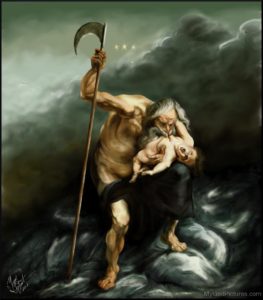
Saturn eating his own children
Saturn, the ruler of the celebration of Saturnalia, is associated with the underworld.
During or close to the Saturnalia celebration Saturn demanded human sacrifices in the form of dead gladiators.
The decapitated gladiator heads were received as offerings for the underworld god connected with Saturn, and the dead bodies were received by Saturn.
This practice was changed due to the influence of a demigod Hercules (in Bible terms we would call such a demigod a giant begotten from fallen angels and human women).
Instead of decapitated gladiator heads, Romans from then on were to offer effigies or masks, and candles were offered instead of the taking of gladiators’ lives. Therefore there’s still the custom to bake human-shaped gingerbread cookies in some countries like the US and Great Britain during Christmas.
Saturnalia was celebrated from around 17th till the 23rd of December. Later it shifted to reach its climax on December 25th, as the rules of the Roman empire changed.
Saturn was usually depicted as an old wise man with a long, grey beard and a sickle in his hand. Sometimes he’s shown with children as he was known to devour his own children.
Mistletoe and Other Sacred Pagan Trees
In 1851, Pastor Henry Schwan of Cleveland, Ohio, appears to have been the person responsible for decorating the first Christmas tree in an American church. His parishioners condemned the idea as a pagan practice; some even threatened the pastor with violence. But objections soon dissipated.
Trees were always worshiped by pagans. Sometimes branches of evergreen fir trees were taken home and decorated around Christmas time.
During Saturnalia, evergreen trees were decorated and paraded through the streets. They were decorated with lit candles. The reason they chose evergreen trees is that they represented fertility. Those trees were also brought into the temple of Saturn during the celebration.

Christmas wreath
According to some sources, garlands, wreaths and other ornaments made of greenery (that could also be mistletoe since it’s the symbol of fertility as it’s ever-green) were hung over doorways and windows, as well as stairways.
Ornaments that were hung on trees were sun symbols, stars, and faces of god Janus and other gods, as well as edible treats shaped like fertility symbols, suns, moons, stars, babies and animals.
Since during Saturnalia the Sun god was worshiped too, the gold color was very common.
Gold stars and ornaments, sun faces, nuts and pine cones nestled among the wreaths of greenery were usual, as well as decorations with lamps, as theologian Tertullian notes.
Mistletoe was the most sacred plant of the Druids. It was given great reverence because it grows on the venerated oak. The custom of kissing under the mistletoe comes from the ancient idea that mistletoe is the oak’s genitals. And so it was believed that an embrace under its red berries would guarantee a fruitful union.
The Egyptians used a date palm in their celebrations of the winter solstice, which commemorated Isis, the “queen of heaven” giving birth to Osiris. Early Scandinavians worshiped the oak tree as their god Woden but later started worshiping evergreens due to the Christmas influence.
Conclusion
As you see, Christmas is a blend of pagan holidays and gods. It was first started to be celebrated in 336 AD in the Roman Empire and it absorbed into itself other pagan fertility celebrations occurring at similar times in order to make it easier for pagans to be converted to Catholicism.
I don’t call those pagans Christians since their conversion was more political than for the reasons of saving them, so it’s likely that Roman Empire was full of unsaved converted pagans that continued their christianized pagan traditions.
Before that date, nobody celebrated this festival. Since its roots lie in a country that invented a hybrid of Christianity and paganism called Roman Catholicism, real Christians should stay away from this celebration. It’s most likely celebrated in veneration of Satan himself, looking at gods that this celebration sprang from.
It’s false to assume that we should celebrate this date as Jesus’ birthday. Firstly, Jews did not celebrate birthdays, and nowhere in the Bible, it’s told to celebrate the day of Jesus’ birth.
Next, we don’t even know when He was born, though it’s least likely that He would be born at the cold night of December, since at that night shepherds came to adore baby Jesus, and they wouldn’t stay out during the cold winter time with their sheep in the fields.
The real reason Christmas is celebrated during this cold month is probably to do with the diminishing of sunlight during this month. Pagans thought that during this month the god of darkness won over the Sun god and that they had to help him out with human and animal sacrifices as well as offerings in order for nights to get shorter and days longer and so that they are assured the fertility of the land.
As we are told by God not to learn the way of the heathen, we should stay away from this pagan holiday no matter how dear it might be to us. We were deceived by Satan in celebrating this unchristian holiday, but since now we are no longer ignorant about its origins, we should not continue celebrating something that has nothing to do with Jesus.

Hi, I'm Simona Rich, the author of this site.
I'm from Lithuania, though most of the time you'll find me somewhere in Asia.
I write about spirituality and self-improvement, and consult on those topics.
Let's connect on Facebook, Instagram and YouTube. My bio is here...

Thank you for validating how I’ve felt but cannot put into words nor do I have the time to research. This is a great overview of something I’ve always participated in but wondered why. I actually don’t want to do it anymore, but always feel pressured into it because it is so family oriented.
Great info. Please cite more footnotes regarding this matter so that the readers has a close look on details. Again thank you so much Sis. Simon Rich and Godbless, for SHARING. 🙂
Just want to clarify, In hindu religion Shiva is not a demon. He is one of the three main Gods. And is God of destruction, if he opens his third eye. But in Hindu religion there are Ghosts (protector or resident of village) who walk through villages and no one cross their paths or build a house in their otherwise will face bad omen. So things are offered to appease them.
Wow lol I’m.so glad I’m.not born a Hindu.. read the bible it says 22th day after Jesus was born. 4 wise men jnckuding 1 from.india came to show respect to the true God of.peace and love and Jesus warned that there will be many false properots anti christ calling themselves “gods ” as God gave the angels power to rule different nations but they took advantage and we Ted humans to worship them so Hinduism is one of the main demonic religions with blue demons many heads arms.halg human half animal in hell that’s how demons are described
I know it’s a shock and hard to accept this but just don’t accept what you were told to believe as a child and research and start with the first ever religion the bible and after that all these fake religions with Islam changing and taking a bit from the bible, I did kundaliji yoga 7 years and thank god I stopped waking up the evil serpent and praying to the evil Hindu demons and chanting those ma tras unaware what they mean and still with third eye and all these magic powers God didn’t want us to know this its all demon knowledge and destruction oure evil you think your God is the main creator how crazy that sounds u think a demon will be like a ghost the real demon is the ine that lies and pretends to be the God to fool.ppl like I!! Just look at kali and check videos ppl hu died n went to hell most r Hindus Sikh Buddhists.
12th*
Amen!!!! Yes super pagan and I’m still not sure why so many “believers are celebrating we need to pray for the lost. Cause narrow is the path. God bless you for speaking so boldly about this amen.